
Rushing into spring
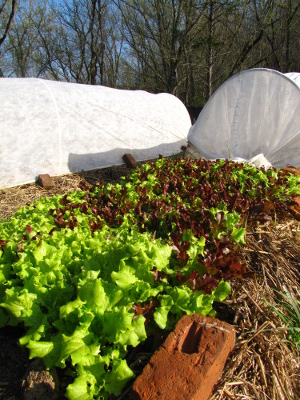 I know it seems a little nuts
to mow and sprinkle in March. My notes
tell me that we started mowing during the second week of April then
watered the garden for the first time during the third week of April in
2010, with both spring activities running a week or two later than that
in 2011.
I know it seems a little nuts
to mow and sprinkle in March. My notes
tell me that we started mowing during the second week of April then
watered the garden for the first time during the third week of April in
2010, with both spring activities running a week or two later than that
in 2011.
But gardeners have to
listen to the weather, and our garden is telling me to get a move on
and pretend this is mid April. I'm rushing out the remaining
spring crops --- every cool weather vegetable except broccoli is in its
final spot in the garden and I'll be putting out the broccoli next
week. In fact, the mule garden is just about full, which is why I
felt it was worthwhile to hook up the irrigation system instead of hand
watering.
Meanwhile, I'm doing
crazy things like starting tomatoes, cucumbers, and watermelons 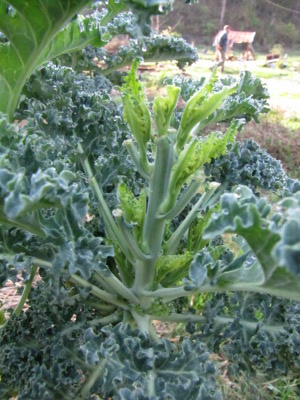 under
quick
hoops --- yes, in
March. The ground is warm enough for the seeds to sprout, and I
figure if the heat wave continues, our spring crops won't last as long
as usual, so we'll need early summer crops to replace them. This
is quite a gamble, but I'll only lose a few cents' worth of seeds if a
late frost is hard enough to get through the row cover fabric.
under
quick
hoops --- yes, in
March. The ground is warm enough for the seeds to sprout, and I
figure if the heat wave continues, our spring crops won't last as long
as usual, so we'll need early summer crops to replace them. This
is quite a gamble, but I'll only lose a few cents' worth of seeds if a
late frost is hard enough to get through the row cover fabric.
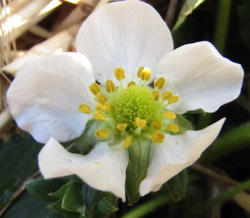
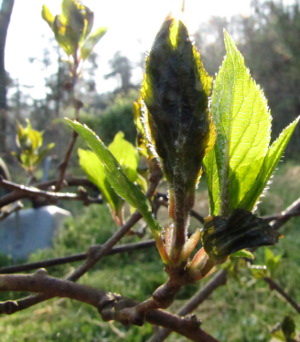 Luckily, this
week's frost didn't
do much damage. As you can see from the yellow center of this
strawberry flower, we might be getting an extra early crop despite the
frost. This strawberry was the lone indicator I left uncovered as
a gauge of the air temperature, which I'm guessing only dropped to
about 31. (Strawberry flowers turn black in the center if damaged
by the frost, which happens at 30 degrees Fahrenheit.)
Luckily, this
week's frost didn't
do much damage. As you can see from the yellow center of this
strawberry flower, we might be getting an extra early crop despite the
frost. This strawberry was the lone indicator I left uncovered as
a gauge of the air temperature, which I'm guessing only dropped to
about 31. (Strawberry flowers turn black in the center if damaged
by the frost, which happens at 30 degrees Fahrenheit.)
As I suspected, the kiwi
was the most tender, showing some frost-nipped leaves on the lower
cordon. It seems like the cold air only lingered in the foot
closest to the ground, though, since higher leaves are still vibrantly
green. I wonder if training a hardy kiwi to grow taller would
give it some frost protection?
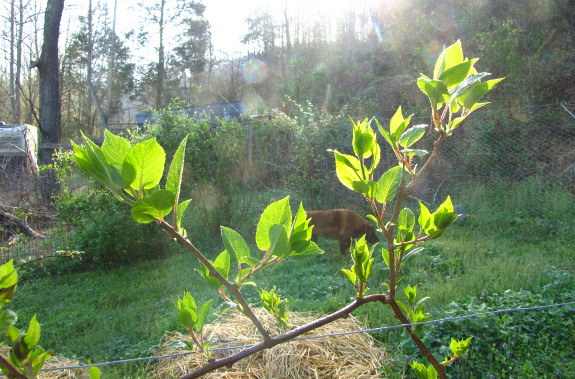
Want more in-depth information? Browse through our books.
Or explore more posts by date or by subject.
About us: Anna Hess and Mark Hamilton spent over a decade living self-sufficiently in the mountains of Virginia before moving north to start over from scratch in the foothills of Ohio. They've experimented with permaculture, no-till gardening, trailersteading, home-based microbusinesses and much more, writing about their adventures in both blogs and books.
Want to be notified when new comments are posted on this page? Click on the RSS button after you add a comment to subscribe to the comment feed, or simply check the box beside "email replies to me" while writing your comment.

We are putting out our garden early this year as well. last year I didn't mow until late in April, I will be mowing for the second time in 2012 this weekend. Crazy.
On a non-related topic, have you two considered recording video to share here via YouTube in addition to what you currently do?
"The ground is warm enough for the seeds to sprout,..."
Can I ask what is the normal length of time the ground needs to be at a certain temperatur eto be considered ready to support seeds?
That's a good question. My guess would be, the average germination time for that seed. Some seeds seem to pop open much faster than others so tomatoes (for example) would need the soil to stay warm for a shorter length of time than peppers.
That said, with warm season crops, you really don't want seedlings to get stunted by cool weather even if it doesn't frost. So if I saw lows beneath the mid forties on the ten day forecast, I wouldn't try anything so crazy as planting tomatoes in quick hoops in March.